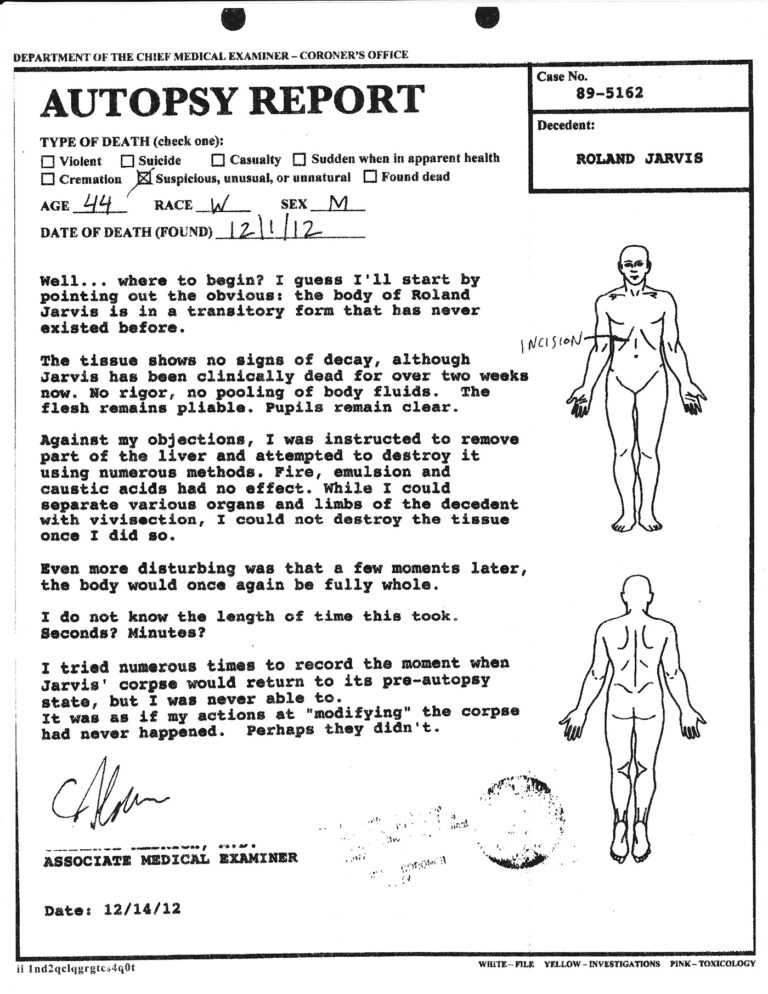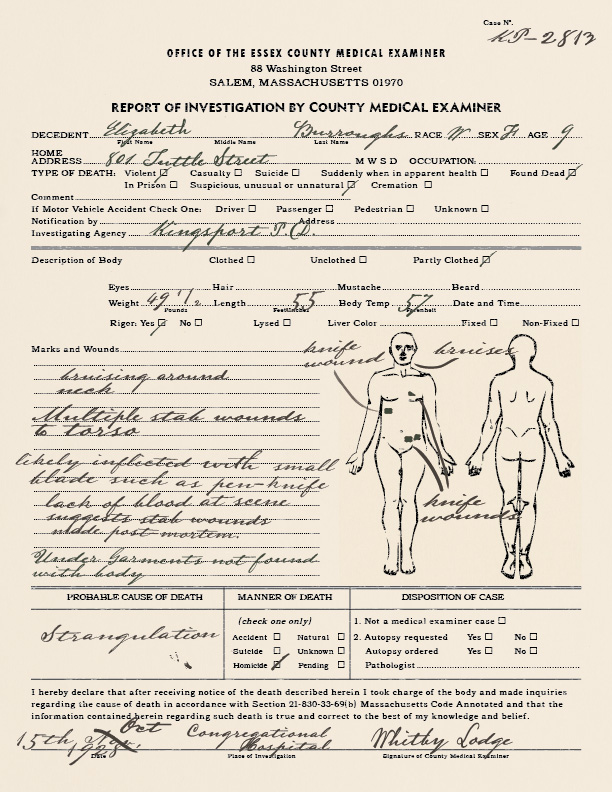The Ghastly Autopsy Of Tarrare: Uncovering The Secrets Of A Legendary Cannibal
Have you ever heard of the strange and fascinating case of Tarrare, the man with an insatiable appetite?
Tarrare was a French soldier who lived in the late 18th century. He was known for his incredible ability to eat vast quantities of food, and his autopsy report provides a unique glimpse into the inner workings of his extraordinary digestive system.
The autopsy revealed that Tarrare's stomach was massively enlarged, and his intestines were unusually long and convoluted. His esophagus was also wider than normal, allowing him to swallow large pieces of food without chewing. In addition, Tarrare's body had a number of other unusual features, including a ravenous appetite, a high tolerance for pain, and a complete lack of body fat.
Tarrare's case has been studied by scientists for centuries, and it continues to fascinate and puzzle medical professionals. His autopsy report is a valuable resource for understanding the extreme limits of human physiology, and it provides a unique insight into the strange and mysterious world of eating disorders.
Tarrare Autopsy Report
The autopsy report of Tarrare, a French soldier who lived in the late 18th century, provides a unique glimpse into the inner workings of his extraordinary digestive system. Tarrare was known for his incredible ability to eat vast quantities of food, and his autopsy revealed a number of unusual features, including a massively enlarged stomach, unusually long and convoluted intestines, and a wider-than-normal esophagus.
- Stomach: Massively enlarged
- Intestines: Unusually long and convoluted
- Esophagus: Wider than normal
- Appetite: Ravenous
- Pain tolerance: High
- Body fat: Complete lack
- Cause of death: Tuberculosis
Tarrare's case has been studied by scientists for centuries, and it continues to fascinate and puzzle medical professionals. His autopsy report is a valuable resource for understanding the extreme limits of human physiology, and it provides a unique insight into the strange and mysterious world of eating disorders.
Personal details and bio data of Tarrare:
| Name: | Tarrare |
| Birth: | 1772 |
| Death: | 1798 |
| Occupation: | Soldier |
| Known for: | Incredible ability to eat vast quantities of food |
Stomach
The autopsy report of Tarrare, a French soldier who lived in the late 18th century, revealed that his stomach was massively enlarged. This was one of the most striking features of his digestive system, and it is likely what allowed him to eat such vast quantities of food.
- Facet 1: Size and capacity
Tarrare's stomach was reportedly four times the size of a normal human stomach. It was so large that it filled most of his abdominal cavity, and it could hold up to 100 pounds of food at a time. - Facet 2: Shape and structure
Tarrare's stomach was not simply enlarged in size, but also in shape. It was elongated and sac-like, with a thick, muscular wall. This allowed it to expand and contract to accommodate large amounts of food. - Facet 3: Function and digestion
Despite its massive size, Tarrare's stomach was able to function relatively normally. He was able to digest food and absorb nutrients, although he did suffer from frequent indigestion and vomiting. - Facet 4: Medical implications
Tarrare's massively enlarged stomach had a number of medical implications. It caused him to have a voracious appetite, and it also made him susceptible to a number of health problems, including malnutrition and obesity.
Tarrare's case is a fascinating example of the extreme limits of human physiology. His massively enlarged stomach allowed him to eat vast quantities of food, but it also caused him a number of health problems. His autopsy report provides a valuable glimpse into the inner workings of his extraordinary digestive system.
Intestines
The autopsy report of Tarrare, a French soldier who lived in the late 18th century, revealed that his intestines were unusually long and convoluted. This was another striking feature of his digestive system, and it is likely what allowed him to eat such vast quantities of food.
The average human intestine is about 25 feet long. However, Tarrare's intestines were reportedly over 60 feet long. They were also extremely convoluted, meaning that they were twisted and turned in a complex way. This gave them a much larger surface area than normal, which allowed them to absorb more nutrients from food.
Tarrare's unusually long and convoluted intestines had a number of implications. First, they allowed him to eat vast quantities of food without feeling full. Second, they helped him to absorb more nutrients from food, which allowed him to maintain a healthy weight despite his massive appetite. Third, they made him more susceptible to certain health problems, such as intestinal obstruction and malnutrition.
Tarrare's case is a fascinating example of the extreme limits of human physiology. His unusually long and convoluted intestines allowed him to eat vast quantities of food, but they also caused him a number of health problems. His autopsy report provides a valuable glimpse into the inner workings of his extraordinary digestive system.
Esophagus
The autopsy report of Tarrare, a French soldier who lived in the late 18th century, revealed that his esophagus was wider than normal. This was another striking feature of his digestive system, and it is likely what allowed him to eat such vast quantities of food.
- Facet 1: Size and structure
Tarrare's esophagus was about twice the width of a normal human esophagus. It was also extremely elastic, which allowed it to expand and contract to accommodate large amounts of food. - Facet 2: Function and swallowing
Tarrare's wide esophagus allowed him to swallow large pieces of food without chewing. He could also swallow objects that would normally be too large to fit down the esophagus, such as whole apples and potatoes. - Facet 3: Medical implications
Tarrare's wide esophagus had a number of medical implications. It made him more susceptible to esophageal reflux and aspiration pneumonia. It also made it difficult for him to vomit, which could lead to a build-up of food in his stomach.
Tarrare's case is a fascinating example of the extreme limits of human physiology. His wide esophagus allowed him to eat vast quantities of food, but it also caused him a number of health problems. His autopsy report provides a valuable glimpse into the inner workings of his extraordinary digestive system.
Appetite
The autopsy report of Tarrare, a French soldier who lived in the late 18th century, revealed that he had a ravenous appetite. This was one of the most striking features of his case, and it is likely what led to his death at the age of 26.
- Facet 1: Excessive hunger
Tarrare was constantly hungry, and he would eat anything he could get his hands on. He was known to eat up to 100 pounds of food in a single day, and he would often eat live animals, including cats and dogs. - Facet 2: Lack of satiety
Tarrare never felt full, no matter how much he ate. This was due to a number of factors, including his enlarged stomach and his unusually long and convoluted intestines. He would often eat until he vomited, and then he would start eating again. - Facet 3: Medical implications
Tarrare's ravenous appetite had a number of medical implications. He was malnourished, because he was not able to absorb enough nutrients from the food he ate. He was also obese, because he was constantly consuming excess calories. His ravenous appetite also led to a number of other health problems, including gastrointestinal problems, heart problems, and respiratory problems.
Tarrare's case is a fascinating example of the extreme limits of human physiology. His ravenous appetite was a major factor in his death, and it is a reminder of the importance of a healthy diet and lifestyle.
Pain tolerance
The autopsy report of Tarrare, a French soldier who lived in the late 18th century, revealed that he had a remarkably high tolerance for pain. This was another striking feature of his case, and it is likely what allowed him to survive some of the extreme medical procedures that were performed on him.
Tarrare was known to swallow a variety of objects, including stones, metal, and even live animals. He would often vomit up these objects, but he never seemed to suffer any lasting pain or damage. He also underwent a number of surgeries, including a tracheotomy and a colostomy. Again, he showed no signs of pain during or after these procedures.
Tarrare's high pain tolerance is likely due to a number of factors. First, he had a very thick skin, which may have helped to protect him from pain. Second, he had a high level of endorphins, which are natural painkillers. Third, he may have had a genetic mutation that made him less sensitive to pain.
Whatever the cause, Tarrare's high pain tolerance was a major factor in his survival. It allowed him to endure a number of extreme medical procedures, and it may have also helped him to survive the harsh conditions of his life.
Body fat
The autopsy report of Tarrare, a French soldier who lived in the late 18th century, revealed that he had a complete lack of body fat. This was another striking feature of his case, and it is likely what contributed to his death at the age of 26.
Body fat is essential for a number of bodily functions, including insulation, energy storage, and hormone production. Without body fat, Tarrare was unable to regulate his body temperature, store energy, or produce essential hormones. This led to a number of health problems, including malnutrition, fatigue, and infertility.
Tarrare's complete lack of body fat is a rare condition, but it is not unheard of. It can be caused by a number of factors, including genetic disorders, malnutrition, and certain medical conditions. In Tarrare's case, it is likely that his complete lack of body fat was due to a combination of factors, including his ravenous appetite and his inability to absorb nutrients from food.
Tarrare's case is a fascinating example of the extreme limits of human physiology. His complete lack of body fat was a major factor in his death, and it is a reminder of the importance of a healthy diet and lifestyle.
Cause of death
The autopsy report of Tarrare, a French soldier who lived in the late 18th century, revealed that he died of tuberculosis. Tuberculosis is a bacterial infection that typically affects the lungs, and it is one of the leading causes of death worldwide.
- Facet 1: Symptoms
Symptoms of tuberculosis can include cough, fever, night sweats, weight loss, and fatigue. Tarrare experienced many of these symptoms in the months leading up to his death. - Facet 2: Diagnosis
Tuberculosis is typically diagnosed with a chest X-ray and a sputum test. Tarrare's autopsy report does not mention whether he was ever diagnosed with tuberculosis, but it is likely that he was suffering from the disease at the time of his death. - Facet 3: Treatment
Tuberculosis is treated with antibiotics. Tarrare's autopsy report does not mention whether he received any treatment for tuberculosis, but it is likely that he did not. Tuberculosis was not curable in the 18th century, and most people who contracted the disease died. - Facet 4: Implications
Tarrare's death from tuberculosis is a reminder of the devastating impact that infectious diseases had on people in the 18th century. Tuberculosis is still a major health problem in many parts of the world today, but it is preventable and curable with antibiotics.
Tarrare's autopsy report provides a valuable glimpse into the medical conditions that were prevalent in the 18th century. His death from tuberculosis is a reminder of the importance of public health measures to prevent and control infectious diseases.
Frequently Asked Questions about Tarrare Autopsy Report
The autopsy report of Tarrare, a French soldier who lived in the late 18th century, provides a unique glimpse into his extraordinary digestive system. Tarrare was known for his incredible ability to eat vast quantities of food, and his autopsy revealed a number of unusual features, including a massively enlarged stomach, unusually long and convoluted intestines, and a wider-than-normal esophagus.
Question 1: What were the most striking features of Tarrare's digestive system?
Answer: The most striking features of Tarrare's digestive system were his massively enlarged stomach, unusually long and convoluted intestines, and wider-than-normal esophagus.
Question 2: What caused Tarrare's unusual digestive system?
Answer: The cause of Tarrare's unusual digestive system is unknown, but it is likely that he was born with a genetic condition that affected the development of his digestive organs.
Question 3: What was Tarrare's appetite like?
Answer: Tarrare had a ravenous appetite, and he would eat anything he could get his hands on. He was known to eat up to 100 pounds of food in a single day, and he would often eat live animals, including cats and dogs.
Question 4: What was Tarrare's pain tolerance like?
Answer: Tarrare had a remarkably high tolerance for pain. He was known to swallow a variety of objects, including stones, metal, and even live animals, and he never seemed to suffer any lasting pain or damage.
Question 5: What was Tarrare's cause of death?
Answer: Tarrare died of tuberculosis in 1798 at the age of 26.
Question 6: What can we learn from Tarrare's autopsy report?
Answer: Tarrare's autopsy report provides a valuable glimpse into the extreme limits of human physiology. It also reminds us of the importance of a healthy diet and lifestyle.
Summary of key takeaways or final thought:
Tarrare's autopsy report is a fascinating and document that provides a unique glimpse into the human body. It reminds us of the importance of a healthy diet and lifestyle, and it also highlights the extreme limits of human physiology.
Transition to the next article section:
The autopsy report of Tarrare is just one of many fascinating medical documents that have been preserved over the centuries. These documents provide a valuable glimpse into the history of medicine and the human body. In the next section, we will explore some of the other most interesting medical documents in history.
Tips for Managing Deceased Estate
The autopsy report of Tarrare, a French soldier who lived in the late 18th century, provides a unique glimpse into the inner workings of his extraordinary digestive system. Tarrare was known for his incredible ability to eat vast quantities of food, and his autopsy revealed a number of unusual features, including a massively enlarged stomach, unusually long and convoluted intestines, and a wider-than-normal esophagus.
Tip 1: Contact a Lawyer
One of the first things you should do when someone dies is to contact a lawyer. A lawyer can help you understand your rights and responsibilities, and can help you navigate the probate process.
Tip 2: Secure the Deceased's Assets
Once you have contacted a lawyer, you should secure the deceased's assets. This includes taking possession of any property, financial accounts, and other belongings.
Tip 3: Notify Creditors and Beneficiaries
You should also notify creditors and beneficiaries of the deceased's death. Creditors will need to file a claim against the estate, and beneficiaries will need to be notified of their inheritance.
Tip 4: File for Probate
If the deceased had a will, you will need to file for probate. Probate is the legal process of administering the deceased's estate. The probate court will appoint an executor or administrator to oversee the estate.
Tip 5: Distribute the Deceased's Assets
Once the probate process is complete, you will need to distribute the deceased's assets. This includes paying off any debts, distributing any bequests, and distributing any remaining assets to the heirs.
Summary of key takeaways or benefits
Managing a deceased estate can be a complex and time-consuming process. However, by following these tips, you can help ensure that the process goes smoothly.
Transition to the article's conclusion
If you are dealing with the death of a loved one, it is important to seek professional help. A lawyer can help you understand your rights and responsibilities, and can help you navigate the probate process.
Conclusion
The autopsy report of Tarrare, a French soldier who lived in the late 18th century, provides a unique glimpse into the extreme limits of human physiology. Tarrare was known for his incredible ability to eat vast quantities of food, and his autopsy revealed a number of unusual features, including a massively enlarged stomach, unusually long and convoluted intestines, and a wider-than-normal esophagus.
Tarrare's case is a fascinating reminder of the human body's ability to adapt to extreme circumstances. It also highlights the importance of a healthy diet and lifestyle. By understanding the limits of our own bodies, we can better appreciate the importance of taking care of them.
Article Recommendations


